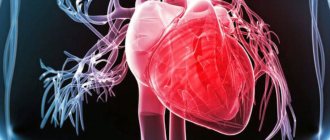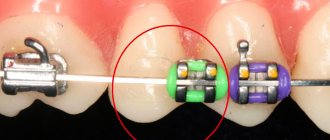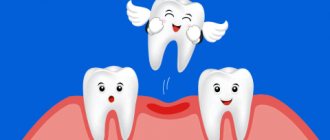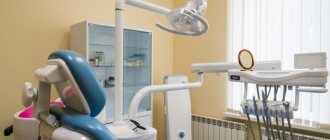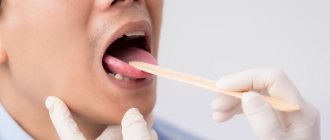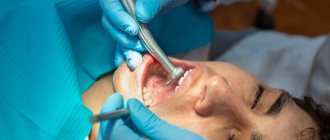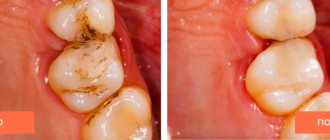Dentistry under sedation is a modern method that allows you to go through an unpleasant procedure with comfort. Parts of the brain responsible for increased levels of anxiety are temporarily blocked with anesthetic drugs. Under their influence, a person quickly calms down, falls into a shallow sleep, while remaining conscious. Ideal conditions are created for the doctor’s comfortable work, helping to significantly improve the quality and efficiency of procedures and perform a large volume in one appointment.
What is sedation in dentistry? How is it different from anesthesia or anesthesia?
Anesthesia in dentistry – anesthesia of the treatment area (site). This is a mandatory manipulation - a traditional injection into the gum near the diseased tooth.
Sedation is a light medical sleep that relieves anxiety and fear. The patient in this state is asleep, but conscious, feels touch, hears the doctor. The main difference from anesthesia is that during sedation a person breathes completely independently. Sedation is accompanied by local anesthesia so that it is not scary or painful. Sedation allows the doctor to monitor the condition of a patient with concomitant diseases - kidney or heart problems, high blood pressure - so all procedures are comfortable and as safe as possible.
Anesthesia or general anesthesia is used during hospital treatment when a complex operation needs to be performed. In this case, the patient’s consciousness is completely turned off, local anesthesia - injections into the gums - is no longer needed, and breathing is controlled by equipment.
The use of sedation assumes the preservation of standard reflexes and the absence of depression of the nervous system. According to reviews from patients of different ages, during treatment they feel lightness and relaxation. On average, an hour after the end of the procedure, the person returns to his normal state and can go home with an escort. Our clinic has a small room where you can rest and sleep after treatment under sedation.
Characteristics of sedation.
When sedation is used, the patient remains conscious and responsive to external stimuli, such as verbal commands from his doctor (“open your mouth,” “close your mouth”) or the sensation of pain.
- If the patient falls asleep during the procedure, it is easy to wake him up.
- All the patient’s protective reflexes (breathing, coughing) remain functional.
- The patient's cognitive functions (perception, reasoning, understanding) may be moderately slow.
- By comparison, with general anesthesia the patient loses all sensation and consciousness.
Additional benefits.
Other benefits of using the sedation method are as follows:
- Some of the drugs used also help raise the patient's pain threshold, i.e. have a certain anesthetic effect;
- Some sedatives create a mild amnesic effect (causing an inability to remember events that occurred during the procedure, or even the procedure itself).
There are risks associated with using any sedative.
Using any type of medication always carries a certain degree of risk of complications and side effects. For this reason, the use of sedation should always be justified.
As a general rule, the type of anesthesia used for a dental procedure should be as minimal as possible. If you are not sure whether you need sedation, ask your dentist why he thinks it is necessary.
Although some types of medications used may increase the patient's pain threshold to a certain extent, this method is primarily used to control the patient's nervousness and fear of the upcoming procedure. This means that even with this method, your dentist will still need to use a local anesthetic.
Types of sedation: superficial and deep
The following sedative methods of relaxing and calming patients are used in dentistry:
- Superficial is the best solution in a situation where the patient requires relaxation for a short period of treatment. Indicated for adults, as well as children from the age of three. A state of pleasant slumber is achieved by inhaling oxygen mixed with nitrous oxide. The nasal mask through which the gas passes is connected to the machine. The doctor can change the ratio of components and dosage based on the individual characteristics of the patient.
- Deep - the medication is administered through an intravenous injection. This technique copes better with severe fear and anxiety. The technique is used for adults and children at least 15 years old. The relaxed state lasts longer than with a superficial state. The patient will need to stay in the clinic for some time and stop driving for 8 hours.
Anesthesiologists at the Refformat dental clinic in Moscow have been working with a wide variety of patients for a long time and their experience makes treatment safe. Any intervention, preparation and installation of prostheses will be comfortable and unnoticeable.
Is there any contraindications for sedation in dentistry for children using nitrous oxide?
There are only a few contraindications for performing ZAKS: age under three years, respiratory diseases, such as rhinitis and runny nose, as well as epilepsy. The fact is that nitrous oxide, even in small concentrations, increases intracranial pressure. This is absolutely safe for a healthy child, since the fluctuations are completely insignificant. But with epilepsy, when the regulation of intracranial pressure is already impaired, this can provoke an attack. That is, in case of epi-status, with a clearly defined epileptic diagnosis, nitrous oxide - oxygen sedation is not used. As for one-and-a-half-year-old, two-year-old and even three-year-old children who are not yet able to interact verbally with a doctor, in the case of serious tooth decay, for example with bottle caries, it is recommended to use anesthesia.
How is the sedation procedure performed?
The procedure consists of several stages. First, you need to get a consultation with a dentist - you meet the doctor and draw up a treatment plan.
For sedation, the patient will need to do a few simple tests:
- ECG.
- Donate blood for general analysis and biochemistry (detailed).
- Donate blood and get test results for hospitalization (for syphilis, HIV, hepatitis).
- If you have diseases, obtain permission from a specialized specialist.
The finished results are sent to the clinic administrators. Be sure to write the surname, initials of the patient and the dentist. The documents are submitted for review to the anesthesiologist, who decides on admission to the operation under sedation and takes into account the possible consequences.
The administrator contacts the patient to clarify the date and time of arrival at the center. On the appointed day, it is recommended to arrive early for the appointment, but do not use personal transport. If necessary, administrators will help you call a taxi to get you back home.
Before the procedure begins, there is a conversation with the anesthesiologist. In the operating room, an individually selected dose of anesthetic will be administered through a nasal catheter and wire. Unlike anesthesia, the patient continues to breathe on his own, plunging into a pleasant half-sleep, without negative sensations. At the end of treatment, the patient is escorted to the rest room, where he has the opportunity to lie down and rest.
Methods of drug administration
Dentistry with sedation in Moscow is represented by various methods of administering medications: inhalation, oral and injection.
Inhalation method
Most often used in pediatric dentistry. The procedure uses nitrous oxide. “Laughing gas” evokes positive emotions in a child from visiting a doctor’s office and undergoing lengthy procedures. At the same time, the doctor’s work becomes significantly easier and more effective.
Oral route
Oral drug sedation is a method of calming in which a drug that eliminates agitation is taken an hour before the main treatment procedure begins. Using this sedation technique, an initial level of stress relief is provided, and the main stage, at which an anesthetic is administered intravenously or an oxygen mask is used, is facilitated.
Injection method
Intravenous sedation is recommended primarily during dental treatment in adults. The injection method involves administering drugs intravenously, directly into the hematopoietic bed. This method is good because it allows you to control the degree of both physical and emotional relaxation.
Indications for the use of pain relief
European and American dentists use sedation in dentistry when performing any manipulations. In Russia, such a procedure can not be performed in every clinic. Treatment and removal of teeth under sedation at Refformat dentistry allows patients to completely calm down and undergo all manipulations in complete relaxation.
Indications for use:
- Severe fear, fear of visiting the dentist, panic.
- Increased vomiting.
- The desire to receive a service with high comfort.
- Reduced pain threshold.
- The need for a long period of simultaneous treatment.
- Vascular or cardiac pathologies (additional consultation with a therapist is required).
- A symptom of cramped (enclosed) spaces.
- A sharp increase in blood pressure due to stress.
Everything you need to know about sedation and anesthesia
One of the most persistent fears from childhood is the fear of the dentist. Most learn to overcome their fear and, despite their anxiety, undergo treatment. But there are people for whom dental treatment is a real nightmare! The irrational fear of a person with dental phobia does not accept any arguments that modern dentistry is painless and anesthesia works almost flawlessly. This leads to serious problems in the oral cavity; a large amount of work is required - treatment and prosthetics of both jaws (partial implantation, removal, root canal treatment).
To avoid such problems or help in an already advanced case, dental treatment under sedation is offered to patients.
Dental treatment using sedation is called differently: treatment according to the “anti-stress” program, treatment “in a dream”, treatment without fear. Despite the fact that sedation has been used in Russian dentistry for more than 10 years, few people know about it. In Europe, almost 60% of dental procedures are performed under sedation and every year sedation is becoming more and more popular. European trends are also developing very quickly in Moscow. Today, almost 20% of metropolitan patients undergo dental treatment under sedation. And although this service is presented on the Omsk market, it has not yet become so widespread. And our task is to convey to patients information about the opportunities that they can take advantage of.
So, sedation or dental treatment in a dream (from the Latin sedatio - to calm down) is a technology that combines a set of measures aimed at calming, physical and emotional relaxation of the patient during treatment.
The sedation procedure in combination with local anesthesia is a safe alternative to deep anesthesia, since there are a number of fundamental, simply colossal differences!
Narcotic analgesics are used during anesthesia. Even the most modern drugs used for anesthesia affect the patient’s condition. Despite the fact that they are indeed practically safe, a slight discomfort is still felt after waking up. Also, anesthesia may be contraindicated in certain diseases, for example, cardiovascular system, diabetes, hypertension. And sedation is a completely safe method. Only mild sedatives are used; they do not suppress the central nervous system as much as anesthesia, have a beneficial effect on the heart, and do not create a risk of pressure changes. Sedation is indicated for people with disorders of the cardiovascular system, hypertension, arrhythmia, and in panic states.
During treatment under sedation, a whole team of experienced specialists works with the patient: a dentist who will directly conduct the treatment, a nurse and an anesthesiologist who will monitor the patient’s health throughout the entire treatment.
During the sedation procedure, an experienced anesthesiologist, using certified Swiss and French drugs, puts the patient into medicated light sleep, while the patient is connected to special equipment that monitors and demonstrates to the team of doctors how deeply the patient is sleeping.
The immersion “into sleep” occurs in comfortable conditions in just a few minutes and almost immediately the patient leaves the feeling of fear, excitement, he relaxes and feels the same as during sleep. BUT! What is very important for both the doctor and the patient is that during treatment the patient remains in contact, hears the doctor’s requests and can fulfill them - for example, turn his head, open or close his mouth, etc.
When carrying out sedation, anesthesia is used, but after the patient is immersed in a medicated sleep. Those. all the negative impressions from being in the dentist's chair: the noise of instruments, some kind of knocking - everything that usually frightens our patients is completely absent here!
During sedation, the anesthesiologist constantly monitors the patient’s vital health indicators - blood pressure, heart, brain activity and all vital organs are reflected on the devices. At any time, the anesthesiologist can remove the patient from the state of sedation without any harm to him or to the treatment process.
Thanks to sedation, the patient’s perception of time changes significantly: long, difficult treatment is subjectively perceived as very short-term. 3-4 hours (and sometimes 6) spent in a chair do not cause discomfort. The patient wakes up rested, full of energy, the treatment process is not recorded in memory, and there are no pain symptoms. Unpleasant, previously tormenting memories (pain, the sound of a drilling machine) are completely gone! This happens because sedation causes a state of deep relaxation, in which the perception of external stimuli (light, sound, etc.) is greatly dulled. There is a result, but no unpleasant sensations or memories!
By the way, after sedation, engraftment progresses much better, since the absence of tension during treatment has a positive effect on the condition of the tissues.
What are the indications for sedation (in some cases, sedation is absolutely necessary - otherwise treatment is even dangerous):
- Fear of dental procedures.
- Long dental procedures. If the patient needs to spend several hours in the dental chair (large complex work is being carried out, for example, sinus lifting, installation of several implants or simultaneous removal of several teeth), we recommend sedation to the patient.
- Stroke, traumatic brain injury. Patients with concomitant severe pathology, when the sensation of pain can cause a sharp deterioration of the condition.
- Hypertension, heart attack (not in the acute period).
- Chronic lung diseases.
- Endocrine diseases.
- In case of allergies or intolerance to local anesthetics, to eliminate the gag reflex.
- Patients with special needs (cerebral palsy, Down syndrome, autism, epilepsy).
There are still a number of contraindications for the sedation procedure, as for any other procedure:
- state of alcohol or drug intoxication
- acute phase of severe somatic diseases (for example, heart attack in the acute period)
- pregnancy
- allergies to medications used
Within 12 hours after treatment, patients are not recommended to drive independently, as the drugs used reduce attention and speed of psychomotor reactions.
In certain cases, according to indications, dental procedures require the use of general anesthesia. The need for general anesthesia occurs more often in children, less often in adults. During general anesthesia, the patient's consciousness and muscle activity are completely switched off; breathing is provided by a ventilator.
Thus, the only risk for the patient is to find a Clinic capable of providing this service at the required high level.
The use of sedation and anesthesia in the practice of dental treatment requires the dental clinic to meet strict requirements. To avoid making a mistake in your choice, pay attention to the availability of the following items in the clinic:
- A medical license not only for carrying out activities using drugs intended for sedation and anesthesia, but also a license for anesthesiology and resuscitation. Only clinics that have these licenses can legally provide services using sedation and anesthesia!
- Separate equipped operating room. This is not just a surgical room - it is an operating room, equipped with the latest generation artificial lung ventilation apparatus, equipment that monitors vital parameters during the period of general anesthesia.
- All procedures involving sedation and anesthesia must be performed by an experienced, qualified dentist and anesthesia team.
- Sedation is carried out using modern equipment and Swiss and French drugs of certified quality.
In Omsk, only a few clinics have a sufficient level to fulfill all these requirements - they offer this service to their patients.
To check all the information, don't hesitate to ask questions! Specialists at the Elite Center clinic say that this procedure is becoming increasingly popular among their patients. Thanks to sedation, clients overcome their fears and decide on long-term necessary treatment!
Sign up online
Registration Online
Contraindications
Sedation is not anesthesia, which has an extensive list of prohibitions on its use. Its negative impact on the human body is minimal. However, this gentle method of sedation also has a certain number of contraindications:
- individual intolerance, allergies to medications;
- colds, flu, ARVI;
- infectious diseases (tuberculosis, hepatitis);
- certain types of chronic diseases;
- myasthenia gravis;
- mental disorders;
- pregnancy;
- alcoholism, drug addiction.
Pros and cons of sedation in dentistry
The main advantage of treatment, removal or prosthetics of teeth under sedation is that it is much easier and more convenient for the doctor to work with a patient who is in a relaxed state. The patient does not experience negative emotions and a persistent feeling of fear from visiting the doctor’s office. In the future, people will more often visit the dental clinic for preventive purposes.
The procedure also has disadvantages, although there are not many of them. The patient should spend an additional hour in the rest room. The cost remains quite high, which is fully explained by the high price of imported materials, high-quality equipment, as well as the duration of treatment. Initially, you will need to spend time and money on tests and consultation with specialists.
